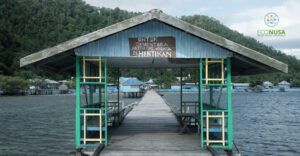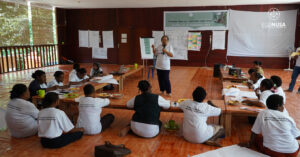
The potential of mangrove crab in South Sorong Regency, West Papua, is deemed a fishery commodity with lucrative business prospect. This is part of the spots of mangrove ecosystem as the haven for mangrove crab breeding at South Sorong coasts. South Sorong has giant mangrove ecosystem. These areas have 77,596 hectares of mangrove or 2.5 percent of the total mangrove areas in Indonesia, 3,416,181.71 hectares.
Demand for fresh crab has currently been on the rise, particularly those for export to China, Taiwan and Singapore. These countries are among importers of crab from Indonesia with high demand.
Currently, shrimp has become the prioritized fishery potential and prominent commodity in South Sorong. However, with the rising demand for crab, the mangrove crab in South Sorong Regency could potentially lead to the second prominent commodity after shrimp with promising business prospect. This region might be considered as the major producer of mangrove crab.
Read also: Mapping Nuruwe Top Commodities
This prospect is potentially to provide contribution to the regional revenue (PAD) in South Sorong. The total of prospective business revenue from crab here is around 360,852,500 lbs or 163,679,940.695 kilograms per year according to Ocean Resource Survey EcoNusa (2020). It is expected to boost up peoples’ income, particularly those associated with the mangrove ecosystem in South Sorong.
“Crab is so abundant. From 5 peoples catching crab, each could get 90 kilograms per day,” said Rince Mangene, a crab seller in Kejase Market.
Mangrove crab is easily found at South Sorong coast. Mangrove ecosystem on the muddy water and large river ending up in the bay could become a suitable habitat for crab breeding. Based on EcoNusa Survey (2020), fisherman at average could collect 200 kilograms of mangrove crab every day along the year. Each fisherman could catch up to 1,300 kilograms of crab of various size in a month.
Read also: Arguni Bay, Nutmeg Stock and Kaimana Forest Commodities
Despite the abundant catch, crab catching method needs to be optimized. It opens a wider scope of supply chain. The crab catcher commonly uses traditional way to get crab. Thus, they have not yet completely implemented any sustainable crab management method.
As to green activist, Yusup Momot, the potentials of mangrove crab are located in some mangrove areas in South Sorong. These areas cover Sayolo, Konda and Saifi. South Sorong is deemed the important fishing area in West Papua. The eastern coasts to the western parts produce various resources. Mangrove crab has not been optimized yet noting the fact that coastal communities still rely on shrimp as their economic priority.
With abundant products from nature, mangrove crab management could potentially be the long-term investment asset. But, the formation of the existing mangrove in South Sorong will influence the production. The utilization of crab should go along with sustainable management business plan to prevent from short-term utilization.
Read also: Restoring Food Independence of Communities in Coastal Halmahera
Meanwhile, some non-profit organizations have urged the West Papua government to assign immediately a new conservation area in South Sorong coastal areas. It means there will be plan for protected water areas to create a sustainable fisheries management. Conservation is expected to run along with the use of fisheries potentials while prioritizing ecological harmony.
Besides, EcoNusa with its Community Business Incubation program has developed a business model for mangrove crab industry development in South Sorong. This initiative will not only strengthen the protection of mangrove ecosystem but also improve fisheries management for the welfare of South Sorong peoples. Initially, EcoNusa held a feasibility study focusing on the amount or resource, stock and economic values for crab business. This will lead to a roadmap for a coastal community economic empowerment at South Sorong.
Editor: V. Arnila Wulandani & Leo Wahyudi







